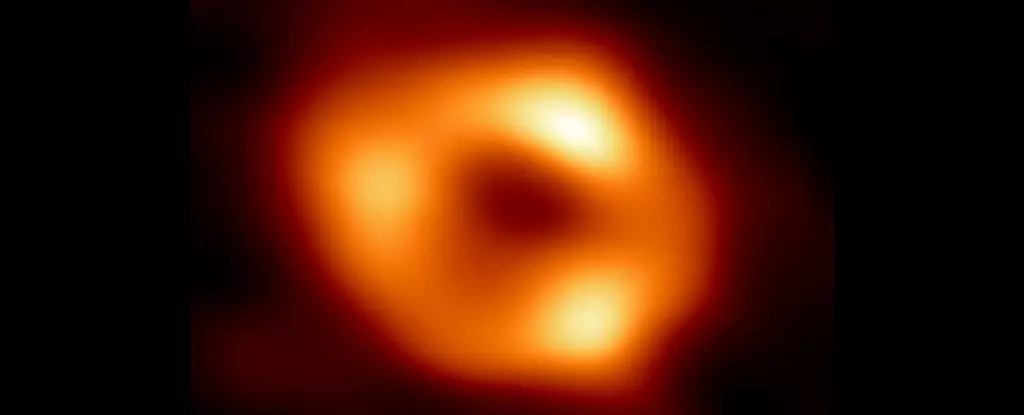The enigmatic realm of black holes has long captivated scientists and astronomers alike due to their profound implications for our understanding of the universe. Among these celestial giants lies Sagittarius A* (Sgr A*), the supermassive black hole at the heart of our Milky Way galaxy. In 2022, the Event Horizon Telescope (EHT) team unveiled a groundbreaking image of Sgr A*, showcasing a bright ring encircling a seemingly dark core. However, recent analysis from researchers at the National Astronomical Observatory of Japan (NAOJ) suggests that our understanding of this astronomical phenomenon might need refinement.
The original image of Sgr A* presented a circular accretion disk, leading many to draw conclusions about the structure and dynamics of matter swirling around the black hole. Yet, a fresh perspective from the NAOJ researchers proposes that the actual shape of the accretion disk is more elongated than previously believed. Utilizing different analytical methods on the EHT data, which was collected using a network of eight ground-based radio telescopes, NAOJ scientists have illuminated how intricate and nuanced black hole imaging truly is.
“We hypothesize that the round appearance may have resulted from errors in the EHT’s imaging analysis,” suggested NAOJ astronomer Miyoshi Mikato. This statement raises crucial questions about the inherent complexities of utilizing radio interferometry, which can be notoriously challenging to interpret due to the data’s fragmented nature. When confronted with these challenges, scientists must innovate and adapt their techniques, leading to discrepancies that can shape our comprehension of such distant phenomena.
The NAOJ team’s analysis reveals an elongated accretion disk, notably brighter in its eastern hemisphere compared to the west. This finding implies that the matter enveloping Sgr A* is in rapid rotation—at nearly 60 percent of the speed of light. The implications of this speed are astounding; it suggests that the forces at play in Sgr A*’s vicinity are immense, as gravitational and magnetic interactions heat up the material being drawn into the black hole.
The material in the accretion disk is superheated, generating emissions primarily in the form of X-rays and visible light, which can be observed by sensitive telescopes. However, various factors affect the accretion disk’s shape. For example, the black hole’s spin and the rate at which matter is fed into it all contribute to the intricate dynamics of this cosmic dance. The gravitational influence of Sgr A* also distorts our perception of the accretion disk, akin to a funhouse mirror that makes understanding its dimensions and behavior even more formidable.
The divergence between the circular and elongated representations of the accretion disk poses significant questions for astrophysicists. The EHT team and the NAOJ researchers utilized the same underlying data but arrived at different interpretations. “No telescope can capture an astronomical image perfectly,” noted Miyoshi. This highlights the fact that observational limitations and the methods employed in analyzing data can profoundly affect scientific conclusions.
The EHT’s imaging process, which resulted in the round black hole representation, involved advanced data techniques designed to address gaps inherent in interferometric datasets. However, the construction of a complete image can introduce artifacts, leading to potential misinterpretations of the actual structures being observed. The NAOJ’s re-analysis, utilizing alternative mapping methodologies, promises a more nuanced understanding of Sgr A* and its surroundings.
The examination and interpretation of Sgr A* serve as a reminder of the evolving nature of astrophysical research. The discrepancies between different analyses emphasize the importance of continuing to refine our observational techniques and theoretical models. Ongoing collaborations among astronomers worldwide, such as enhancements to the EHT, will likely yield even more detailed images and analyses of black holes in the future.
Moreover, understanding the intricacies of black hole accretion disks is paramount for grasping the underlying mechanics of the universe’s most mysterious entities. The insights generated from Sgr A*’s re-analysis can guide future research directions and potentially enable astronomers to uncover more secrets about the nature of black holes and their significant role in galaxy formation and evolution.
Sagittarius A* continues to be an object of fascination, one that challenges our comprehension of the universe while simultaneously pushing the boundaries of modern astrophysics. With ongoing advancements in observational capabilities and data analysis techniques, we can expect our understanding of this awe-inspiring black hole to deepen. As each new revelation unfolds, the narrative surrounding Sgr A* expands, offering a glimpse into the enigmatic workings of our cosmos. The pursuit of knowledge is a winding road, one that progressively leads us closer to the extraordinary secrets that black holes harbor.


Leave a Reply